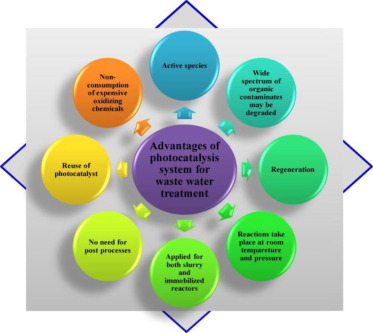Advantages of Photocatalytic Processes: Harnessing the Power of Light
Introduction
Photocatalysis, a process that utilizes light to trigger chemical reactions, has gained significant attention for its remarkable advantages across various domains. From environmental benefits to energy efficiency, the advantages of photocatalytic processes are transforming the way we approach challenges. In this article, we delve into the multifaceted advantages of photocatalysis, exploring its impact on cleaner air, self-cleaning surfaces, energy efficiency, antibacterial properties, water purification, material versatility, environmental impact, and much more.
Cleaner Air and Environment
One of the standout advantages of photocatalysis lies in its ability to purify the air we breathe. The process involves the use of photocatalysts, typically titanium dioxide, to break down pollutants and allergens when exposed to light. This innovative approach not only reduces air pollution but also contributes to a healthier environment. As we witness a surge in urbanization, the demand for clean air becomes more crucial than ever.
Self-Cleaning Surfaces
Imagine surfaces that clean themselves, reducing the need for constant maintenance and cleaning efforts. Photocatalytic coatings achieve just that. By applying these coatings to various materials, from glass to concrete, surfaces become self-cleaning as they break down organic contaminants when exposed to sunlight. This breakthrough technology finds applications in architecture, making buildings more sustainable and reducing the environmental impact of cleaning products.
Energy Efficiency
Photocatalysis extends its advantages to the realm of energy efficiency. Harnessing solar energy through photocatalytic processes presents a promising avenue for sustainable power generation. Photocatalytic materials can convert sunlight into clean energy, offering a potential solution to the global quest for renewable energy sources. This not only contributes to a greener planet but also addresses the pressing need for sustainable energy alternatives.
Antibacterial Properties
In the age of heightened awareness regarding hygiene and infection control, photocatalysis emerges as a powerful tool. The antibacterial properties of photocatalytic materials make them effective in disinfecting surfaces, reducing the spread of harmful microorganisms. This is particularly valuable in healthcare settings, where maintaining a sterile environment is paramount, and in public spaces to mitigate the risk of infections.
Water Purification
Access to clean water is a global concern, and photocatalysis offers a promising solution for water purification. The process involves the degradation of pollutants and pathogens in water when exposed to light. By utilizing photocatalysis in water treatment, we can address challenges related to water scarcity and contamination, paving the way for a more sustainable water future.
Versatility in Materials
Photocatalytic materials showcase versatility in various industries. From construction materials to textiles, the incorporation of photocatalysis enhances durability and longevity. The self-cleaning properties of these materials also contribute to reducing maintenance costs, making them an attractive choice for businesses and industries looking for sustainable and cost-effective solutions.
Reducing Environmental Impact
Comparing photocatalysis with traditional methods reveals its potential to significantly reduce the environmental impact of various processes. Whether it’s air purification, water treatment, or surface cleaning, photocatalysis offers a greener alternative by minimizing the use of chemicals and energy-intensive methods. This shift towards environmentally friendly technologies aligns with the global effort to combat climate change.
Challenges and Limitations
While the advantages of photocatalysis are undeniable, it is essential to acknowledge the challenges and limitations associated with this technology. Factors such as the need for specific light conditions, potential toxicity of certain photocatalysts, and scalability issues pose hurdles that researchers and industry experts are actively working to overcome.
Future Developments
The field of photocatalysis is dynamic, with ongoing research leading to continuous advancements. Future developments may include improved photocatalytic materials, enhanced efficiency, and expanded applications. As technology evolves, we can anticipate even more groundbreaking uses of photocatalysis that contribute to solving global challenges.
Real-world Applications
To truly appreciate the advantages of photocatalysis, examining its real-world applications is crucial. From air purification systems in urban areas to self-cleaning glass facades in modern architecture, the impact is tangible. Case studies and success stories highlight the transformative potential of photocatalytic processes in diverse contexts.
Consumer Products
Beyond industrial and construction applications, photocatalysis has found its way into everyday consumer products. From self-cleaning clothing to personal care items with antibacterial properties, consumers are increasingly benefiting from the integration of photocatalytic technologies into their daily lives. This widespread adoption signals a shift towards a more sustainable and hygienic lifestyle.
Economic Benefits
The economic advantages of incorporating photocatalysis into various processes are significant. Reduced maintenance costs, energy efficiency, and the potential for creating new markets for photocatalytic products contribute to a positive economic outlook. Businesses that embrace this technology can simultaneously improve their environmental footprint and bottom line.
Global Adoption
The adoption of photocatalysis varies globally, influenced by factors such as regulatory policies, cultural preferences, and economic considerations. Understanding these regional differences is crucial for the widespread adoption of photocatalytic technologies. As awareness grows, we can expect a more unified global effort to harness the advantages of photocatalysis for a sustainable future.
Conclusion
In conclusion, the advantages of photocatalytic processes are far-reaching and transformative. From contributing to cleaner air and water to revolutionizing the durability of materials, photocatalysis is a beacon of innovation. While challenges exist, ongoing research and developments promise a future where the benefits of photocatalysis become even more pronounced. Embracing this technology is not just about efficiency; it’s a commitment to a more sustainable and environmentally conscious world.







